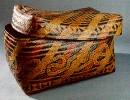 | Find Louisiana State Museum on Facebook |
 | Find Louisiana State Museum on Twitter |
| 2016 Sunset Report |
| OLG & DCRT Strategic Plan 2020-21 through 2024-25 |

- Quality - Louisiana State Library
85% of the users of the State Library indicated that the State Library's services and resources was a good value for the State.Source: The Impact of the Louisiana Department of Culture, Recreation and Tourism on Louisiana's Economy and Quality of Life for Louisiana's Citizens - June 2006
- Louisiana's deep water ports
Did you know that Louisiana's five deep water ports handle more than 457 million tons of U.S. waterborne commerce a year? - Quality - Louisiana State Library
85% of the users of the State Library indicated that the State Library's services and resources was a good value for the State.Source: The Impact of the Louisiana Department of Culture, Recreation and Tourism on Louisiana's Economy and Quality of Life for Louisiana's Citizens - June 2006
- Atchafalaya Heritage Area
The Atchafalaya Heritage Area has been designated by Congress as a National Heritage Area.
- Impact - DCRT Returns Investment Dollars to Louisiana
For every state tax dollar spent by the Department of Culture, Recreation and Tourism, $5.86 is returned to the State Treasury and citizens of Louisiana.Source: The Impact of the Louisiana Department of Culture, Recreation and Tourism on Louisiana's Economy and Quality of Life for Louisiana's Citizens - June 2006
- Impact - Louisiana Office of Tourism Tops Returns on Investment
$13.90 is the return on investment for every dollar spent by the Office of Tourism. Over 175,000 people were directly employed by the Louisiana travel and tourism industry in 2004. In terms of production, $5.9 billion (3.8%) of Louisiana's Gross State Product was directly attributable to expenditures by visitors to LouisianaSource: The Impact of the Louisiana Department of Culture, Recreation and Tourism on Louisiana's Economy and Quality of Life for Louisiana's Citizens - June 2006
- Impact - Supporting the Louisiana Arts
Every dollar in state support for the Arts leverages $7 in earned and contributed revenue. Louisiana's cultural enterprises provide nearly 144,000 jobs for Louisiana citizens, accounting for 7.6% of total employment. Arts has a total economic impact of $934 million in Louisiana.Source: The Impact of the Louisiana Department of Culture, Recreation and Tourism on Louisiana's Economy and Quality of Life for Louisiana's Citizens - June 2006
- Impact - Visitors Generate State Revenue
In terms of tax revenues, visitor spending accounted for $677 million of 2004 Louisiana revenues, or 8.3% of the total 2004 State Budget.Source: The Impact of the Louisiana Department of Culture, Recreation and Tourism on Louisiana's Economy and Quality of Life for Louisiana's Citizens - June 2006
- Quality - Louisiana State Museums
95% of State Museum's visitors strongly agreed or agreed that the State Museum was an educational experience and has expanded their awareness of Louisiana's cultural history.Source: The Impact of the Louisiana Department of Culture, Recreation and Tourism on Louisiana's Economy and Quality of Life for Louisiana's Citizens - June 2006
- Quality - Historic Preservation and the Arts
78-80% of Louisiana residents believe that historic preservation and arts are important and should be high priorities.Source: The Impact of the Louisiana Department of Culture, Recreation and Tourism on Louisiana's Economy and Quality of Life for Louisiana's Citizens - June 2006
- Impact - Louisiana Serve Program
The Louisiana Serve Program in the Office of Lieutenant Governor returns 2.8 million in non-state revenue to Louisiana. - Impact - Louisiana State Museum
The Office of State Museum returns $6.99 for every tax dollar spent.Source: The Impact of the Louisiana Department of Culture, Recreation and Tourism on Louisiana's Economy and Quality of Life for Louisiana's Citizens - June 2006
- Impact - Louisiana State Parks
Visitor spending at Louisiana State Parks returns $3.23 in state taxes for every dollar spend on operating and maintaining all our beautiful parks. Out-of-state visitors to Louisiana State Parks spent almost $12 million in Louisiana and produced an economic impact of over $24 million. Louisiana residents spent another $29.2 million while visiting the parks.Source: The Impact of the Louisiana Department of Culture, Recreation and Tourism on Louisiana's Economy and Quality of Life for Louisiana's Citizens - June 2006
- Impact - Scenic Byways Program
The Scenic Byways program leverages $1.56 for every dollar spent by the program.Source: The Impact of the Louisiana Department of Culture, Recreation and Tourism on Louisiana's Economy and Quality of Life for Louisiana's Citizens - June 2006
- Louisiana State Parks and the National Register
Thirteen Louisiana State Parks sites are on the National Register of Historic Places. They include:
• Audubon State Historic Site
• Centenary State Historic Site
• Fort Pike State Historic Site
• Fort Jesup State Historic Site
• Longfellow-Evangeline State Historic Site
• Mansfield State Historic Site
• Marksville State Historic Site
• Plaquemine Lock State Historic Site
• Port Hudson State Historic Site
• Poverty Point State Historic Site
• Otis House at Fairview-Riverside State Park
• Rosedown Plantation State Historic Site
• Winter Quarters State Historic Site - Louisiana State Parks Visitation
Nearly two million people visited a Louisiana State Park last year. - Louisiana State Parks Grow and Renew
The Louisiana Office of State Parks has spent nearly $80 million in major construction projects since 2004, providing two brand-new parks and a new historic site, adding cabins and campsites to existing parks and building visitor center at one park, the preservation area and three historic sites. - Louisiana State Parks Wireless Internet
The Louisiana Office of State Parks provides free wireless internet access at all 20 recreational parks. Extensive coverage areas include most cabins, RV slips and campsites. - Louisiana State Parks Online Reservations
You can now make online reservations for cabins, campsites, lodges and group camps – at www.ReserveLaStateParks.com - Louisiana State Parks Honors National Parks Service Senior Pass Program
Visitors who hold an America the Beautiful Senior or Access Pass, and whose home State Park system honor the America the Beautiful passes for camping discounts, are entitled to a 50% reduction on camping fees at Louisiana State Parks. Certain restrictions apply, see State Parks' fees & facilities page for more information. - Louisiana State Parks Draw Media Attention
Louisiana State Parks sites have been featured in movie and television releases including "True Detective," CBS’ "Zoo," and "NCIS: New Orleans," "G.I. Joe: Retaliation," "Selfless," "Devil’s Due," and commercials for Popeyes and Toyota. - Capitol Park Welcome Center
The main meeting room in the Capitol Park Welcome Center is named after Margaret Taylor, wife of U.S. President Zachary Taylor. The couple resided in a small house near the present day location of Capitol Park until Taylor was elected to the Presidency.
| Introduction | Native Americans | Colonial Louisiana | The Louisiana Purchase | Territory to Statehood | Battle of New Orleans |
| Antebellum Louisiana I | Antebellum Louisiana II | Antebellum Louisiana III | The Civil War | Reconstruction I | Reconstruction II |
At the time of French settlement in 1700, many Indian groups lived in Louisiana, which then encompassed the Mississippi Valley and Gulf Coast region. These groups ranged from small clans of hunters to large communities of farmers. Several Louisiana societies established extensive cultural and economic exchange networks and traded material goods, belief systems, language patterns, technology, and recreational practices with other native groups in North America and probably even in Mexico, Central America, and the Caribbean, and later with European settlers.
 | Chitimacha Basket 20th Century This double-woven lidded basket is an excellent example of the Chitimacha weaver's art. |
Native American Timeline
| 10,000 to 5000 b.c | 5000 to 2000 b.c. | 2000 b.c. to a.d. 1700 | a.d. 1700 |
| Paleo-Indians | Meso-Indians | Neo-Indians: Poverty Point Tchefuncte Marksville Troyville-Coles Creek Caddo/Plaquemine-Mississippian | Major Native Groups on the Eve of French Settlement: Natchez Speakers Atakapa Opelousa Caddo Tunica Koroa Yazoo Houma Bayougoula Acolapissa Mugulasha Okelousa Quinapisa Tangipahoa Chitimacha Washa and Chawasha |
Societies
As in most Indian societies, Louisiana Indians carried out tasks defined along gender lines. Men ruled and defended the tribal communities and hunted and constructed buildings and canoes with tools they made. Women cared for children and the elderly, planted crops, and made clothes and utensils, which they used to prepare foods and decorate their homes and religious centers. One early French settler, Antoine Simon Le Page du Pratz, observed that "most of the labour and fatigue falls to the share of the women," while Indian men had "a great deal of more spare time than the women."
Hunting was economically pivotal as a source of food, clothing, tools and jewelry. Indians stalked deer, bear, bison and a multitude of smaller game animals. When Europeans came to Louisiana, they noted that the Natchez in particular practiced the "communal surround." Upon sighting a deer, about a hundred men formed an open crescent. They drove the deer from side to side until it dropped to the ground exhausted.
Beliefs and Practices
Though their specific beliefs and practices varied, Indian religions focused on placing humans in harmony with nature and the world. The Natchez, Acolapissa, Caddo, Houma, Taensa, and Tunica constructed sacred buildings, some of which they raised on truncated pyramidal earth mounds, comparable to Mesoamerican temples.
Louisiana Indians honored their dead with celebrations of dance, song, and food. Jean-Bernard Bossu, an early French colonial observer, described a Louisiana Indian celebration that closely resembled the European All Saints' Day:
- Each family gathers at the cemetery and weeps as it visits the boxes containing the bones of its ancestors. After leaving the cemetery, the Indians indulge in a great feast.... In the early part of November they have an important holiday called the feast of the dead or the feast of souls.
Homes, Clothing & Recreation
There were no tepees in Louisiana. Rather, Louisiana's first families lived and worshipped in palmetto-thatched houses, beehive-shaped grass houses, woodframe houses, and wattle-and-daub houses and temples.
Women prepared and cooked the food that they gathered and grew and that the men hunted and fished. Louisiana Indians boiled, roasted, baked and parched their food.
Native American women also manufactured all the clothing. Popular clothing materials were feathers, bark, cloth, and hides, as well as furs from deer, bear, bison, and smaller game animals. Both men and women fashioned such body ornaments as necklaces, bracelets, armbands, rings, and ear and nose plugs from locally available shells and pearls and imported copper.
Like Europeans and Africans of the same time period, the natives of Louisiana amused themselves with various games and sporting events. Long before Europeans arrived in the Mississippi Valley, Louisiana Indians gambled on the outcome of sporting events and games of chance. Players and spectators alike risked their earnings on all sorts of games and sports--wrestling, footracing, archery, dice, and toli, a game adopted by the French and called raquette. Dancing and music were often a part of these tribal sporting events, as well as feasts and religious ceremonies. With music in the background, Louisiana Indians performed as groups, pairs, and individuals.




